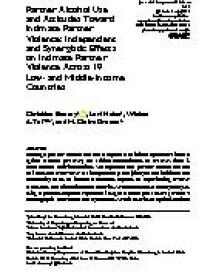Partner Alcohol Use and Attitudes Toward Intimate Partner Violence : Independent and Synergistic Effects on Intimate Partner Violence Across 19 Low- and Middle-Income Countries
Although partner alcohol use and acceptance of intimate partner violence against women (IPVAW) are critical determinants of IPVAW, little is known about their interaction. We explored how partner alcohol use and attitudes toward IPVAW act independently and jointly at the individual and community levels to influence women’s reports of experiencing IPVAW across low- and middle-income countries. We conducted secondary analyses using a pooled sample of reproductive-aged women (n = 166,621) from 19 Demographic and Health Survey datasets. We fit a series of a priori-defined mixed-effects logistic regression models of the total effects, within- and between-community effects, and contextual effects of past-year IPVAW on partner alcohol use, acceptance of IPVAW, and their multiplicative interaction. We then fit a series of models stratified by community alcohol use and acceptance of IPVAW. Partner alcohol use (odds ratio [OR] = 3.20; 95% confidence interval [CI]: [3.07, 3.33]) and women’s acceptance of IPVAW (OR = 1.83; 95% CI: [1.76, 1.89]) were consistently associated with increased odds of experiencing IPVAW. Sub-multiplicative interactions were present for within-community effects (ratio of OR = 0.86; 95% CI: [0.79, 0.94]), whereas supra-multiplicative interactions were present for betweencommunity effects (ratio of OR = 1.002; 95% CI: [1.0002, 1.005]) and contextual effects (ratio of OR = 1.003; 95% CI: [1.0007, 1.005]).
The odds of IPVAW associated with partner alcohol use was greatet in communities with lower partner alcohol prevalence and lower acceptance of IPVAW. It is important to consider norms and attitudes toward IPVAW alongside alcohol use when understanding epidemiological patterns of IPVAW and potential opportunities for preventive programs and policymaking. Future studies should focus on the complex interactions, at multiple social levels, between interacting risk factors for IPVAW.
Geachte bezoeker,
De informatie die u nu opvraagt, kan door psychotraumanet niet aan u worden getoond. Dit kan verschillende redenen hebben,
waarvan (bescherming van het) auteursrecht de meeste voorkomende is. Wanneer het mogelijk is om u door te verwijzen naar de bron
van deze informatie, dan ziet u hier onder een link naar die plek.
Als er geen link staat, kunt u contact opnemen met de bibliotheek,
die u verder op weg kan helpen.
Met vriendelijke groet,
Het psychotraumanet-team.
In: Journal of Interpersonal Violence ; ISSN: 0886-2605
https://doi.org/10.1177/08862605221134645
Online ahead of print, doi: 10.1177/08862605221134645


